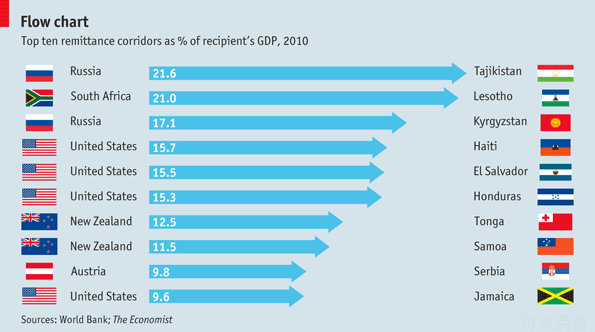特惠-26考研冲刺
特惠-27考研课
双证-在职硕士
免联考-同等学力
复试分数线
26复试全面指导
模拟复试面试
26考研-全套真题
26考研估分
保研-路线图
27考研-智能择校
27考研-英语测评
27考研-新大纲对比
热门-计算机择校

扫码加入训练营
牢记核心词
学习得礼盒
2015考研英语复习正是强化复习阶段,考研英语阅读在考研英语中占了40分,所以考研英语阅读是英语科目中重要的一项。新东方名师范猛老师曾建议过考研生需要坚持每天泛读10-15分钟的英文原刊。强烈推荐了杂志《经济学人》.杂志中的文章也是考研英语的主要材料来源.希望考研考生认真阅读,快速提高考研英语阅读水平。
New rivers ofgold
新的资金流向
Remittances from unlikely places are helpingpoor countries in the downturn
意外的汇款在经济低迷时帮助贫困国家
In tapachula, a furnace of a city in southernMexico, people line up inside an air-conditionedbranch of Banco Azteca to process theirremittances. Last year Mexicans received anestimated $24 billion from friends and familyworking abroad, mainly in the United States, withwhich Mexico forms the world's busiest remittance corridor (see map). But a closer look atthe Tapachulan queue shows how the remittance business is changing. Many are not Mexicansreceiving cash from America, but migrant workers sending it back home to Guatemala orHonduras. “Very similar to what happens at the other border,” observes Jorge LuisValdivieso, the bank's regional administrator, referring to Mexico's better-known northernfrontier.
他伯拉在墨西哥南部一个火炉区域,这里的大部分人阿紫别克银行的一个有空调的房间内排队处理他们的汇款。去年墨西哥人从海外朋友和家人那里得到大约240亿美元,大部分来自美国,为此墨西哥成了世界上最防盲的汇款渠道(如地图)。但是近距离观察塔帕丘拉的长队发现汇款业务怎么变化。大部分不是墨西哥人从美国得到现金,而是移民工人汇回他们的家乡危地马拉和洪都拉斯。“这与另一边的边境发生的情况很相似,”Jorge Luis Valdivieso说,这个银行的区域行政长官,指的是墨西哥著名的北部边境地区。

The value of remittances to poor countries is enormous. Since 1996 they have been worthmore than all overseas-development aid, and for most of the past decade more than privatedebt and portfolio equity inflows. In 2011 remittances to poor countries totalled $372billion, according to the World Bank (total remittances, including to the rich world, came to$501 billion). That is not far off the total amount of foreign direct investment that flowed topoor countries. Given that cash is ferried home stuffed into socks as well as by wire transfer,the real total could be 50% higher.
这些汇款的价值对于贫穷国家来说是巨大的。自从1996年其价值已经超过了所有的海外发展救助资金,并且对于过去的十年来说其价值超过了私人债券和股票的流入。在2011年汇向贫穷国家的总额已经达到3720亿美元,根据世界银行的统计(总汇款,包括流向富裕国家的,已经达到5010亿美元)。这与流向贫穷国家的总的外资直接投资相差不远。这些钱可能通过装在袜子里偷渡回家或通过电汇到家,真实总额可能要高出50%。
Remittances are not just big, but growing—they have nearly quadrupled since the turn of themillennium—and resilient. In 2009, when economies around the world crashed, remittancesto poor countries fell by a modest 5%, and by 2010 had bounced back to record levels. Bycontrast, foreign direct investment in poor countries fell by a third during the crisis, andportfolio inflows fell by more than half. “The most remarkable thing about remittancestoday is their continued growth, year after year, despite the global economic crisis,” saysDilip Ratha, head of migration and remittances at the World Bank.
这些汇款不仅数量大,而且不断增长并且有弹性,在千禧年左右汇款增加了量增加了四倍。在2009年,世界经济下滑的时候,汇向贫穷国家的钱稍微下降了5%,并且到了2010年这有反弹到历史水平。相反,在经济危机期间外资直接向贫穷国家的投资下降了三成,证券投资流入下贱了一半。“尽管世界经济危机的今天汇款最大的特点就是其数量年复一年的增长,”Dilip Ratha说,世界银行移民和汇款长官。
One reason for this apparent boom is simply that the data are better. Money senders suchas Western Union and MoneyGram have improved their reporting to central banks. Oversighthas tightened since September 11th 2001. This has led to big jumps in some numbers:Nigeria posted a near-doubling of remittance receipts in 2007. Where governments aresensitive about providing information, economists have used other methods. India, forinstance, subjects remittances to Bangladesh to stringent tests. But by examiningmigration data, the World Bank reckons that some $3.8 billion probably crosses the borderevery year.
明显增长的一个原因是数据更容易得到了。汇款邮寄公司譬如西部联合公司和速汇金公司已经提高其对中央银行的上报。自从2001年9月11日起已经加强了监管力度这导致汇款大数量的增加,尼日利亚报告2007年汇款收入将近翻了一番。 那些政府对上报信息敏感的地方,经济学家已经采取了其他的方法。比如印度对于汇向孟加拉国的汇款进行严厉的检查。但是通过检查银民数据,世界银行预计每年有38亿美元穿越边境线。
Partly thanks to these techniques, it is now known that remittances come from a widervariety of countries than was previously thought. This might in turn explain how they haveavoided being affected by Wall Street's hiccups. In 1970 46% of recorded remittances werereckoned to originate in America. By 2010 America's share was just 17%. One big newplayer is the Gulf, which has sucked in migrant workers since the oil boom. Saudi Arabia isnow the world's biggest sender of remittances after America, posting $27 billion in 2010,mostly to the families of South Asians and Africans who toil on its building sites and clean itshomes. More than half of all remittances to South Asia come from the Gulf; worldwide, theregion sends almost as many remittances to poor countries as western Europe does.
部分归因于这些技术,现在知道汇款比以前认为的来自更多的更大范围的国家。这也可以解释为什么他们能够不受华尔街震荡的影响。在1970年46%有源可查的汇款来自美国。到2010年美国的份额只占了17%。一个新的大玩家来自海湾地区,自从石油经济暴增吸引了大批的移民工人。现在沙特阿拉伯是自美国之后最大的汇款输出国,在2010年寄出了270亿美元,大部人到了南亚和非洲家庭中,他们用这些钱整理房屋清理房间。所有的汇款中超过一半是从海湾地区邮寄到南亚地区的;世界范围内,这些地区向贫穷地区送出的汇款大致与西欧国家持平。
Expensive oil has made Russia a big destination for immigrants, too. In 2000 it was only the17th-biggest remitter in the world—indeed, it was a net receiver. But by 2010 it was thefourth-largest sender, dispatching nearly $19 billion, mostly to Central Asia. Remittancesfrom Russia are worth more than a fifth of Tajikistan's economy (see chart).
高昂的石油价格也俄罗斯成为一个巨大的移民输入地。在2000年的时候它实际上只是世界第十七位汇款输出国,他是净输入国。到了2010年它是第四大输出国,输送了大概190亿美元,大部分输送到中亚地区。来自俄罗斯的汇款相当于塔吉克斯坦整个经济的六倍(见图表)
Though they are less volatile than many types of income, remittances are not immune tofluctuations. Cash flows to Mexico last year were still 12% lower than their pre-crash peak,partly because many Mexican migrants worked in the American construction sector, whichis still reeling. The “Arab spring” of 2011 made a dent in remittance receipts in the MiddleEast and Africa, as migrant workers from the region fled countries such as Libya. Anexception was Egypt, where receipts shot up by 14%. One reason may be that exiledEgyptians returned home with their savings; another is that a fall in property pricesencouraged émigrés to snap up bargains.
尽管并不像大部分类型的收入,汇款并不受经济波动的影响。去年流入墨西哥的现金仍然比以前的最大值少了12%,部分死因为墨西哥裔移民大部分在美国建筑部门工作,这些仍在倒退中。在“阿拉伯之春”的2011年中东和非洲地区外汇收入下降了,因为移民工逃离一些国家例如利比亚。埃及一个例外,其进款猛增了14%。一部分原因是流亡的埃及人带着他们的储蓄回到家乡;另一个原因是物价下降鼓励一民工抢购廉价物品。
Currency fluctuations can also skew remittance patterns. American greenbacks and euros areno longer sought after in those African countries where currencies have appreciated sharplyin real terms thanks to demand for the commodities they export. “When you send dollarsback to a family in Angola, they don't feel as rich as before,” says Marcelo Giugale of theWorld Bank. Working in Europe for five years no longer buys a house back home.
现期的货币波动可能影响汇款模式。美元和欧元再不是非洲国家追逐的对象了。这些地区的货币急剧升值这归因于对他们出口商品需求的增加,“当你送回美元到阿格拉家庭中的时候,他们不会像以前那样感到富有。”来自世界银行的Marcelo Giugale 说,在欧洲工作5年再也不能在家乡购买一套房子了。
The question is whether migrants will react by spending longer in far-flung destinations, or bystaying closer to home. Many already go for the second option: one-tenth of remittances toAfrica come from within the continent. South Africa sends most of its $1.4 billion inremittances to its neighbours, for example.
问题是这些移民是否愿意为长远的目标做出反映,或者呆在家里。很多人已经选择第二个选择了:十分之一汇向非洲国家的汇款来自欧洲国家。例如,南非已汇款形式想起邻邦输送1亿美元。
In the rich world, many countries have closed their borders to protect home-grown workers.America has made its southern frontier harder to cross, which partly explains the slowdownin immigration from Mexico. Emigration has risen, too, since the economy stalled. Butperhaps because they know it will be harder to come back, migrants are staying longer.According to the Pew Hispanic Centre, 27% of Mexicans deported from America in 2010 hadbeen in the country for at least a year, up from 6% in 2005. That may help explain whyremittances from America fell by only 5% in 2009, whereas in Britain, which has openborders with some of its biggest senders of immigrants, they fell by 27% (exchange ratesplayed a part, too). Stricter border controls keep migrants in as well as out, and theremittances flowing.
在富裕国家,很多国家已经关闭器边境以保护其本土的工人,美国已经使其南部边境线变得更难穿越,这部分说明了墨西哥汇款的降低。自从经济失速以后移民处境也增加了,但是可能因为他们知道回去更困难的,移民呆的时间更长了。根据裔研究中心的报告2010年27%被驱逐出境的墨西哥人至少在美国带了一年,甚至有6%自2005年就在了。那可以帮助解释为什么2009年来自美国的汇款仅仅下降了5%,然而在柏林,这个与其汇款输送人所在国家开放边境的下降了27%(汇率起了也起了一定的作用),严格的边境控制使得移民进出保持相对不变,和汇款上升。
8月底,很多高校2015年考研招生简章已经发布,请广大15年考生关注,预计到8月底9月初,2015年全国硕士研究生招生简章会陆续发布完成,新东方在线小编第一时间跟踪发布,请大家收藏关注!另有研究生专业目录、考研参考书等最新考研信息,帮助考生及时了解目标院校招生政策及信息。另有西医综合专业考试
新东方名师考研课程 购买进行中
【英语阅读资料】这里有↑↑↑

 资料下载
资料下载
2014年-2025年考研历年真题汇总
发布时间:2024-04-25扫码添加【考研班主任】
即可领取资料包
考研大纲PDF电子版下载-历年(附解析)
发布时间:2024-04-25扫码添加【考研班主任】
即可领取资料包
2026年考研政数英备考资料zip压缩包
发布时间:2024-04-25扫码添加【考研班主任】
即可领取资料包
考研英语大纲词汇5500打印版(基础必备)
发布时间:2024-04-25扫码添加【考研班主任】
即可领取资料包
新东方在线考试模拟题【12套】
发布时间:2024-04-25扫码添加【考研班主任】
即可领取资料包
2026年考研专业课知识点总结
发布时间:2024-04-25扫码添加【考研班主任】
即可领取资料包
新东方考研资料下载地址
发布时间:2023-05-17新东方在线考研资料合集
下载方式:微信扫码,获取网盘链接

目录:
1.2013-2023年近10年政数英真题及解析PDF版(新东方)
2.2013-2023年专业课考试历年真题及解析PDF版
3.24考研复习备考资料大合集:大纲+备考资料+词汇书+考前押题+自命题
资料介绍:
1.2013-2023年近10年政数英真题及解析PDF版(新东方)
 、
、
2.2013-2023年专业课考试历年真题及解析PDF版


3.24考研复习备考资料大合集

3.24考研复习备考资料:考研大纲

3.24考研复习备考资料:政数英备考资料+自命题真题

------------------
考研备考过程中,尤其是专业课部分,参考往年的考试真题,对于我们的复习有更好的帮助。北京大学考研真题资料都有哪些?小编为大家进行了汇总。
北京大学考研真题资料-公共课

北京大学考研真题资料-专业课


以上就是关于“北京大学考研真题资料下载(历年汇总)”的整理,更多考研资料下载,请关注微信获取下载地址。
2024考研公共课必背知识点汇总
发布时间:2023-01-03扫码添加【考研班主任】
即可领取资料包
2013-2023考研历年真题汇总
发布时间:2023-01-03扫码添加【考研班主任】
即可领取资料包
考研英语大纲词汇(PDF可打印)
发布时间:2023-01-03扫码添加【考研班主任】
即可领取资料包
2024考研专业课知识点总结
发布时间:2023-01-03扫码添加【考研班主任】
即可领取资料包
2023考研政治 内部押题 PDF
发布时间:2022-11-16扫码添加【考研班主任】
即可领取资料包
徐涛:23考研预测六套卷
发布时间:2022-11-16扫码添加【考研班主任】
即可领取资料包
考研政数英冲刺资料最新整理
发布时间:2022-11-16扫码添加【考研班主任】
即可领取资料包
23考研答题卡模板打印版
发布时间:2022-11-16扫码添加【考研班主任】
即可领取资料包
2023考研大纲词汇5500PDF电子版
发布时间:2022-07-28扫码添加【考研班主任】
即可领取资料包
考研历年真题(公共课+专业课)
发布时间:2022-07-28扫码添加【考研班主任】
即可领取资料包
考研英语阅读100篇附解析及答案
发布时间:2022-01-07扫码添加【考研班主任】
即可领取资料包
新东方考研学霸笔记整理(打印版)
发布时间:2022-01-07扫码添加【考研班主任】
即可领取资料包
2001-2021年考研英语真题答案(可打印版)
发布时间:2022-01-07扫码添加【考研班主任】
即可领取资料包
考研英语词汇5500(完整版下载)
发布时间:2022-01-07扫码添加【考研班主任】
即可领取资料包
2022考研政审表模板精选10套
发布时间:2022-01-07扫码添加【考研班主任】
即可领取资料包
历年考研真题及答案 下载
发布时间:2021-12-09扫码添加【考研班主任】
即可领取资料包
考研政审表模板汇总
发布时间:2020-06-17扫码添加【考研班主任】
即可领取资料包
近5年考研英语真题汇总
发布时间:2020-06-17扫码添加【考研班主任】
即可领取资料包
考研英语大纲词汇5500
发布时间:2020-06-17扫码添加【考研班主任】
即可领取资料包
2022考研12大学科专业排名汇总
发布时间:2019-11-21扫码添加【考研班主任】
即可领取资料包
2023考研政治复习备考资料【珍藏版】
发布时间:2019-11-21扫码添加【考研班主任】
即可领取资料包
考研英语万能模板+必备词汇+范文
发布时间:2019-11-21扫码添加【考研班主任】
即可领取资料包
考研数学一、二、三历年真题整理
发布时间:2019-11-21扫码添加【考研班主任】
即可领取资料包

添加班主任领资料
添加考研班主任
免费领取考研历年真题等复习干货资料

 推荐阅读
推荐阅读
为了让考研的同学更高效地复习考研英语,新东方在线考研频道整理了“考研英语1阅读错几个后的复习计划”,考研的同学可以了解一下,希望对大家有所帮助。
为了让考研的同学更高效地复习考研英语,新东方在线考研频道整理了“考研英语二阅读篇数及题型分析”,考研的同学可以了解一下,希望对大家有所帮助。
为了让考研的同学更高效地复习考研英语,新东方在线考研频道整理了“考研英语阅读理解的总结与反思”,考研的同学可以了解一下,希望对大家有所帮助。
来源 : 网络 2025-06-13 08:02:00 关键字 : 考研英语阅读理解
为了让考研的同学更高效地复习考研英语,新东方在线考研频道整理了“提高考研英语一阅读理解的五大策略”,考研的同学可以了解一下,希望对大家有所帮助。
为了让考研的同学更高效地复习考研英语,新东方在线考研频道整理了“探索考研英语阅读文章的逻辑结构”,考研的同学可以了解一下,希望对大家有所帮助。
来源 : 网络 2025-06-12 08:03:00 关键字 : 考研英语阅读

 资料下载
资料下载
扫码添加【考研班主任】
即可领取资料包
扫码添加【考研班主任】
即可领取资料包
扫码添加【考研班主任】
即可领取资料包
扫码添加【考研班主任】
即可领取资料包
扫码添加【考研班主任】
即可领取资料包
扫码添加【考研班主任】
即可领取资料包
新东方在线考研资料合集
下载方式:微信扫码,获取网盘链接

目录:
1.2013-2023年近10年政数英真题及解析PDF版(新东方)
2.2013-2023年专业课考试历年真题及解析PDF版
3.24考研复习备考资料大合集:大纲+备考资料+词汇书+考前押题+自命题
资料介绍:
1.2013-2023年近10年政数英真题及解析PDF版(新东方)
 、
、
2.2013-2023年专业课考试历年真题及解析PDF版


3.24考研复习备考资料大合集

3.24考研复习备考资料:考研大纲

3.24考研复习备考资料:政数英备考资料+自命题真题

------------------
考研备考过程中,尤其是专业课部分,参考往年的考试真题,对于我们的复习有更好的帮助。北京大学考研真题资料都有哪些?小编为大家进行了汇总。
北京大学考研真题资料-公共课

北京大学考研真题资料-专业课


以上就是关于“北京大学考研真题资料下载(历年汇总)”的整理,更多考研资料下载,请关注微信获取下载地址。
扫码添加【考研班主任】
即可领取资料包
扫码添加【考研班主任】
即可领取资料包
扫码添加【考研班主任】
即可领取资料包
扫码添加【考研班主任】
即可领取资料包
扫码添加【考研班主任】
即可领取资料包
扫码添加【考研班主任】
即可领取资料包
扫码添加【考研班主任】
即可领取资料包
扫码添加【考研班主任】
即可领取资料包
扫码添加【考研班主任】
即可领取资料包
扫码添加【考研班主任】
即可领取资料包
扫码添加【考研班主任】
即可领取资料包
扫码添加【考研班主任】
即可领取资料包
扫码添加【考研班主任】
即可领取资料包
扫码添加【考研班主任】
即可领取资料包
扫码添加【考研班主任】
即可领取资料包
扫码添加【考研班主任】
即可领取资料包
扫码添加【考研班主任】
即可领取资料包
扫码添加【考研班主任】
即可领取资料包
扫码添加【考研班主任】
即可领取资料包
扫码添加【考研班主任】
即可领取资料包
扫码添加【考研班主任】
即可领取资料包
扫码添加【考研班主任】
即可领取资料包
扫码添加【考研班主任】
即可领取资料包

 阅读排行榜
阅读排行榜
 相关内容
相关内容